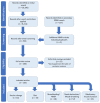The role of craniofacial maldevelopment in the modern OSA epidemic: a scoping review
- PMID: 34984972
- PMCID: PMC8974375
- DOI: 10.5664/jcsm.9866
The role of craniofacial maldevelopment in the modern OSA epidemic: a scoping review
Abstract
Objectives: There is increasing recognition that environmental factors affect human craniofacial development and our risk for disease. A scoping review of the literature was performed looking at environmental influences on craniofacial development to better understand this relationship and investigate what further study is needed to determine how this relationship may impact obstructive sleep apnea.
Methods: A comprehensive literature search was performed using the Ovid Medline database from inception to May 2020 with relevance to craniofacial development in 5 clinically oriented variables: diet, secular change, breastfeeding/nonnutritive sucking habits, nasal obstruction/mouth breathing, and masticatory muscle function. The Oxford Centre for Evidence-Based Medicine Levels of Evidence was used to assess studies based on study design.
Results: We initially identified 18,196 articles, of which 260 studies were fully reviewed and 97 articles excluded. The remaining 163 articles were categorized as follows: secular change (n = 16), diet (n = 33), breastfeeding/nonnutritive sucking habits (n = 28), nasal obstruction/mouth breathing (n = 57), and masticatory muscle function (n = 35). Ninety-three percent of included studies reported a significant association between craniofacial morphology and environmental factors. The majority of studies were characterized as low-level-of-evidence studies, with 90% of studies being a level-of-evidence of 4 or 5.
Conclusions: The studies in this review suggest that environmental factors are associated with changes in craniofacial development. However, most studies were heterogeneous and low-level studies, making strong conclusions about these relationships difficult. Future rigorous studies are needed to further our understanding of environmental influences on craniofacial development and obstructive sleep apnea risk.
Citation: Yu JL, Tangutur A, Thuler E, Evans M, Dedhia RC. The role of craniofacial maldevelopment in the modern OSA epidemic: a scoping review. J Clin Sleep Med. 2022;18(4):1187-1202.
Keywords: breastfeeding; craniofacial development; diet; mandible; masticatory muscles; maxilla; nasal obstruction.
© 2022 American Academy of Sleep Medicine.
Conflict of interest statement
All authors have seen and approved the manuscript. Dr. Yu is supported by the T32 Training Grant in Sleep and Sleep Disorders (5-T32-HL-007953-18) at the Division of Sleep Medicine, University of Pennsylvania, and by a Sleep Research Society CDA Award (023-JP-19). Dr. Dedhia receives support relevant for this project from the National Institutes of Health (1R01HL144859-01). The authors report no conflicts of interest.
Figures





References
-
- Remmers JE , deGroot WJ , Sauerland EK , Anch AM . Pathogenesis of upper airway occlusion during sleep . J Appl Physiol. 1978. ; 44 ( 6 ): 931 – 938 . - PubMed
-
- Senaratna CV , Perret JL , Lodge CJ , et al. . Prevalence of obstructive sleep apnea in the general population: a systematic review . Sleep Med Rev. 2017. ; 34 : 70 – 81 . - PubMed
Publication types
MeSH terms
Grants and funding
LinkOut - more resources
Full Text Sources

